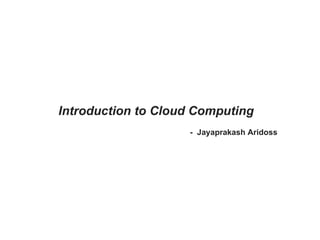
Intro To Cloud Computing
- 1. Introduction to Cloud Computing - Jayaprakash Aridoss
- 4. Background of Cloud Computing Grid Computing Parallel computing Clustered computing Load balancing Utility Computing Virtualization improves resource utilization and reduces Capital and Operational Expenditures Pay – per use Cloud Computing Grid + Utility + more…such security, backup.. New buzz of IT
- 7. Types of Cloud Computing Private Cloud , infrastructure is deployed and operated exclusively for an organization or enterprise. It may be managed by the organization or by an independent third party and may exist on-premise or off-premise at a hosting facility. Public Cloud infrastructure is available to public or many industry groups or customers. It is owned by the organizations promoting and selling cloud services. This can also be thought of as an “on-demand” and a “pay-as-you-go” environment where there are no on-site infrastructure or management requirements; however, the environment is no longer within the customer’s perimeter. Ex, Amazon’s Elastic Compute Cloud (EC2), Google Apps, and Salesforce.com. Hybrid Cloud is a composition of two or more clouds, private and public. Each cloud retains its unique entities. Clouds may be federated or bound together by technology, enabling data and application portability. Hybrid cloud is prevalent for several reasons. For example, many organizations have existing private cloud infrastructure and may need to extend their capability, or often the benefits of combining both private and public clouds may be a more efficient model to handle an unexpected surge in the application workload.
- 8. Cloud Storage Infrastructure Distributed Physical Storage Isolated Virtualized Storage Storage Aggregation or Virtual/physical storage devices Cloud storage functionalities such Data protection, de-duplication, encryption, compression, tiering, Load balancing, replication, backup, archive, chargeback User management (Policy & resource management) Cloud file services (NFS/CIFS, SOAP,REST) Cloud optimized storage devices (FC, iSCSI) Application, and platform software/middleware Cloud user access interface Backend Front end
- 9. Storing a file to Cloud Storage Thin Client / User access device Application, and platform software/middleware Policy Management Resource Management Cloud Storage Services Interface User Authentication systems Virtual Storage Layer Physical Storage Layer 1 Physical Storage Layer 2 Physical Storage Layer 3 1. Thin client passes file to application 2. Application sends the request and the file to cloud storage using web service protocols such as SOAP/REST 3. Cloud storage service interface passes the file and metadata to the user request management node 4. User request management process invokes policy management process and resource management process to define policy and determine layout 5. File is stored as object to virtual image which is mapped to distributed physical resources 6. Object ID is returned to the application through cloud storage service interface
- 12. Future of Cloud –Talk of IDC and Mkt
Hinweis der Redaktion
- National Institute of Standards and Technology (NIST), Information Technology Laboratory
- Grid Computing: In grid computing environment, the workload is distributed or transferred to nodes with needed computing resources. Usually a chain of nodes, such as servers, are networked to form the grid. These nodes are typically clustered and are kept ready to handle the distributed workload. Grid computing enables parallel computing, although its utility is best for large workloads. Utility Computing: The main benefit of utility computing is capital and operational cost savings. Most datacenters have underutilized servers, storage networks, and storage, due to over provisioning to handle peak workload, sudden spike, and projected growth. Utility computing introduces ‘pay only for what you use’ models, allowing organizations to hire computing resources when required. Cloud Computing: The backbone of cloud computing is utility computing, however, it offers a wider picture. It can be applied internal to an organization to build its own cloud infrastructure, in addition to utility services. Cloud provides the opportunity of unlimited scalability, significant cost savings, internet based access, workload balancing, dynamic and fine granular provisioning, and self service requesting. It is an emerging technology, but already considered as another generation of computing, after mainframe, personal computer, client-server computing, and the web.
- Cloud computing enables cloud services such as backup, archive, web e-mail, and word processing for individual and business.
- Private Cloud, infrastructure is deployed and operated exclusively for an organization or enterprise. It may be managed by the organization or by an independent third party and may exist on-premise or off-premise at a hosting facility. Public Cloud infrastructure is available to public or many industry groups or customers. It is owned by the organizations promoting and selling cloud services. This can also be thought of as an “on-demand” and a “pay-as-you-go” environment where there are no on-site infrastructure or management requirements; however, the environment is no longer within the customer’s perimeter. Hybrid Cloud is a composition of two or more clouds, private and public. Each cloud retains its unique entities. Clouds may be federated or bound together by technology, enabling data and application portability. Hybrid cloud is prevalent for several reasons. For example, many organizations have existing private cloud infrastructure and may need to extend their capability, or often the benefits of combining both private and public clouds may be a more efficient model to handle an unexpected surge in the application workload. Sorce - NIST
- Simple Object Access Protocol – SOAP Representational State Transfer – REST Common Internet File System - CIFS
- 1. Thin client passes file to application 2. Application sends the request and the file to cloud storage using web service protocols such as SOAP/REST 3. Cloud storage service interface passes the file and metadata to the user request management node 4. User request management process invokes policy management process and resource management process to define policy and determine layout 5. File is stored as object to virtual image which is mapped to distributed physical resources 6. Object ID is returned to the application through cloud storage service interface